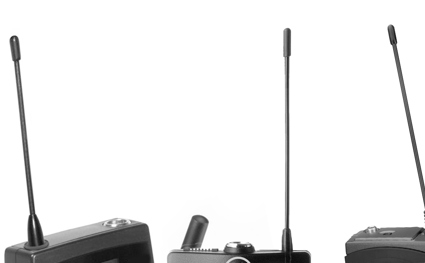Digital wireless and mics – it’s digital so why bother?
This article looks into the special problems that microphones in connection with digital transmission systems may provide if not designed well.

When we talk about a wireless microphone we actually have to consider this device as consisting of two different components: a microphone and a radio transmitter (and of course there must be a receiver somewhere to complete the system).
For the last decades we have more or less learned how to cope with the situation of having an analog microphone capsule and related circuitry in a short distance from an antenna radiating FM modulated radio waves. If both microphones and transmitters are designed properly, the transmission can take place without introducing any substantial noise. Now, however, it has become common to use so-called digital wireless systems.
Why digital systems?
In a digital wireless system the digital technology is applied both to the signal processing of the audio signal path and in the modulation of the carrier frequency.
Converting the analog audio to the digital domain leaves a possibility of improving the frequency range, in practice from DC to 20 kHz. Also the linearity and the dynamic range can improve from the digital techniques. Normally the analog signal is converted to a linear digital format, for instance 44.1 kHz/24 bit (>1 Mbps). This however contains too much information to be modulated, hence a bit reduction algorithm is applied; in this way the bit stream is reduced which again reduces the bandwidth of the radio signal.
Normally the available digital systems provide stable transmission at a lower transmission power compared to the traditional FM-systems.
One obvious advantage of a digitally modulated signal is the possibility of transmitting an encrypted signal that reserves the audio for the ears intended to hear it and nobody else.
What is the difference between analog FM and Digital modulation?
The principle of transmission is the same in both analog and digital systems: a radio frequency (RF) carrier, typically in the MHz - GHz range, is modulated by the signal to be transmitted.
When using analog FM modulation much is done to keep the modulated frequency of a transmission channel within given audio signal limits. It is the level of the modulating signal that determines the frequency deviation; if there is no modulation, only an empty carrier frequency is put on air. Raising the level of the LF signal results in a higher frequency deviation on both sides of the basic carrier frequency and a wider bandwidth. The space taken up by a channel depends on the allowed frequency deviation. Ideally this should never exceed ± 75 kHz in high quality analog FM-transmission. The bandwidth of the individual channel is directly related to the possible number of channels within a given frequency band.
In the digital transmission system, however, we still have a carrier frequency which is modulated. Now the carrier is modulated to reflect the digital code, basically zeros and ones. At the same time the modulation should be as effective as possible. For instance transmitting with less power makes the transmitters’ batteries last longer. Reducing the bandwidth of the signal makes space for more channels. Error correction or low error techniques may result in a more stable transmission.
Now we are approaching the techniques which are most likely to be applied in real life products.
The Quadrature phase-shift keying (QPSK) is a somewhat more complicated technique, however it allows a relatively high bit stream for a given bandwidth and with a reasonable error rate. A technique like this is used not only for digital wireless microphones but also for other digital radio communication like Bluetooth connections.
To make the transmission stable a differential coding is applied, meaning that the information is not expressed by the absolute phase, but the change of phase. This is called Differential QPSK.
The basic idea is that no value ends at zero. Timing diagram for QPSK. The binary data stream is shown beneath the time axis. The two signal components with their bit assignments are shown the top and the total, combined signal at the bottom.
What are the disadvantages of digital wireless?
One obvious disadvantage related to all digital techniques is the latency. However, the amount of latency is not much, typically in the range of 3 to 5 ms. This corresponds to the microphone placed 1 to 2 meters further away compared to a wired microphone (with no delay).
In some receivers the basic noise seems to be higher in comparison to the analog systems. This goes especially if the output is on microphone level. The DACs utilized in the receiver must be high quality, low noise types.
The lower power fed into the transmitter antenna is actually an advantage. This should guarantee less induced noise in the audio circuitry. However, the noise introduced – when present – is somewhat more annoying compared to that of an analog system.
What does RFI from digital wireless sound like?
All audio engineers know what kind of noise a roaming mobile phone can generate in different audio equipment. In some digital wireless microphone systems this noise can be heard as noise bursts or in some cases a kind of high frequency ringing.
How to protect the microphone from a disturbing digitally modulated RF?
At the core it is a question of avoiding any disturbing sounds to occur in the audio signal. This is secured by having microphones – and audio circuitry – that will decouple all RF noise. The DPA microphones have built-in filters to avoid the unwanted noise. However, it is also a question of handling the systems in an appropriate way, for instance don’t wrap the microphone cable around the antenna, be sure the microphone cable connector is mounted in a proper position, etc.

